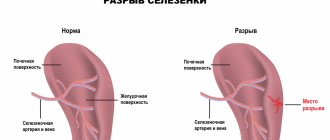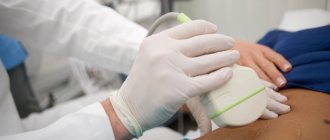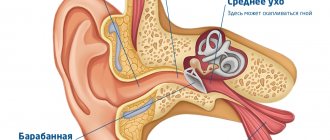Intercostal neuralgia is a pain syndrome: the sensation of pain occurs along one of the intercostal nerves. Acute, “shooting” pain in itself is a rather unpleasant factor, but in the case of intercostal neuralgia it is especially frightening. We usually interpret acute pain in the chest area as cardiac pain. If the nerve running between the lower ribs or the subcostal nerve (running under the lower rib) is affected, we may mistakenly believe that the source of pain is in the abdominal cavity.
How to distinguish intercostal neuralgia from heart pain
First of all, it is worth saying two things. First, you need to know that not all pain in the chest area is related to the heart. Therefore, you don’t need to be too scared right away. And second: the diagnosis can only be made by a doctor. If you have a tingling sensation in your chest, this is a significant reason to see a doctor. The doctor will figure out the cause of the pain. In addition, neuralgia also needs to be treated.
Intercostal neuralgia most often occurs in older people, but it also occurs at a young age (people who lead a sedentary lifestyle and also swimmers are at risk). In children, intercostal neuralgia can occur, as a rule, during a period of intensive growth.
A characteristic sign of intercostal neuralgia is severe pain along the affected nerve. The pain can come in attacks or be constant. As a rule, the pain becomes more intense when inhaling, exhaling, as well as any movement affecting the chest. If you press on the area between the ribs where the causative nerve passes, the pain intensifies. In this case, the entire nerve is felt; the pain can radiate to the arm, neck, shoulder, lower back. Along the affected nerve, numbness and blanching of the skin may occur.
Thus, if with pain in the chest area there is a dependence on changes in body position, there is no shortness of breath (a typical symptom of cardiac pathology), the pain intensifies with palpation, then most likely neuralgia is occurring. You can also focus on the effectiveness of the medications taken: cardiac medications do not help with neuralgia, but sedatives can reduce pain.
However, in any case, it is necessary to consult a doctor for a diagnosis and prescription.
What can hurt your chest?
To understand why the chest hurts when you inhale, you will have to remember the anatomical structure and location of the organs in this part of the body. In the thoracic region are located:
- the heart, located in the cardiac “bag” - the pericardium;
- thoracic spinal column;
- trachea, branching in the lower part into bronchi;
- the aorta is the largest artery of the human body;
- lungs covered with pleura - a protective film that softens their friction against the costal arches.
In the lungs themselves there are bronchi and bronchioles, which are supplied with nerve cells, as well as the pleura and all the organs listed above.
Any pathology in the thoracic organs - pleura, trachea, heart or pericardium - accompanied by inflammation or irritation of pain receptors can cause pain in the chest when inhaling.
In addition, colic from an inflamed gallbladder or from the stomach or duodenum affected by an ulcerative process can radiate (spread) into it. Finally, for various reasons, the intercostal muscles may hurt from excessive stress (for example, pain during intense training or due to prolonged coughing) or the ribs themselves, if they have been injured. As you can see, there is a lot of pain in the chest and each case should be dealt with separately.
Causes of intercostal neuralgia
All causes of intercostal neuralgia can be reduced either to a pinched nerve root (the nerve is compressed at the point of exit from the spinal canal) or to irritation or compression of a nerve already in the intercostal space.
Intercostal nerve radicular syndrome is usually caused by one of the following:
- osteochondrosis of the thoracic spine;
- intervertebral hernia;
- tumor processes;
- other diseases of the spine.
Much more often, intercostal neuralgia occurs as a result of factors affecting the nerve in the intercostal space. The main reasons here are:
- chest injuries;
- herpes infection (herpes zoster);
- muscular-tonic syndrome due to excessive physical activity or working in an awkward position;
- hypothermia;
- for women - wearing tight underwear (bra). First of all, those who have a poorly developed subcutaneous fat layer should be careful;
- compression of the nerve by a growing tumor (pleura, chest wall) or an aneurysm of the descending thoracic aorta;
- factors affecting the entire nervous system (poisoning, hypovitaminosis).
Factors that increase the risk of intercostal neuralgia are:
- diabetes;
- problems with immunity;
- age-related changes in blood vessels;
- alcoholism;
- hormonal disorders;
- stress, depressed mental state;
- long-term use of potent medications.
Right when inhaling
What could be the cause of the pain that is felt on the right when inhaling? The most common triggers for this type of chest pain are:
- diseases of the digestive system (gastroesophageal reflux, cholestasis, chronic cholecystitis, biliary colic with cholelithiasis) can provoke the spread of pain to the right chest;
- pulmonary diseases - right-sided pneumonia with a complication in the form of dry pleurisy, pulmonary embolism - pulmonary embolism (in 50% of cases it gives chest pain when inhaling on the right);
- injuries to the bones of the thoracic region on the right;
- neurological conditions;
- diseases of the spine;
- psychogenic conditions (panic attacks, cardialgia, cardiophobia).
The true cause of chest pain when inhaling on the right can only be determined by visiting a doctor.
Methods for diagnosing intercostal neuralgia
If you suspect intercostal neuralgia, you should consult a neurologist.
In most cases, the diagnosis is established based on the patient’s complaints, medical history and examination of the patient directly at the appointment. The doctor pays attention to the patient’s posture: in an effort to reduce pain by reducing pressure on the affected nerve, the patient tilts the body in the opposite direction. The intercostal spaces are palpated in the area where the pain is located. Loss of sensitivity and blanching of the skin is established.
Sometimes instrumental and laboratory diagnostics may be required:
ECG
An ECG is performed in case of pain on the left side. The goal is to rule out heart problems. In combination with an ECG, echocardiography (ultrasound of the heart) may be prescribed. More information about the diagnostic method
Chest X-ray
A chest x-ray is performed to exclude diseases of the lungs and pleura.
More information about the diagnostic method
Ultrasound of the abdominal organs
A survey ultrasound examination can exclude diseases of the abdominal organs.
More information about the diagnostic method
Neuromyography
Electroneurography is prescribed, as a rule, if the traumatic nature of intercostal neuralgia is suspected.
X-ray of the spine
X-ray of the thoracic spine allows us to determine the causes of radicular syndrome. A CT scan or MRI may also be ordered to evaluate the condition of the spine.
More information about the diagnostic method
Blood test for antibodies to the herpes virus
It is carried out if there is a suspicion of a viral origin of intercostal neuralgia.
Sign up for diagnostics To accurately diagnose the disease, make an appointment with specialists from the Family Doctor network.
Why does it hurt when you exhale?
Chest pain has so many faces that a huge number of questions arise around it. For example, some patients are interested in why pain appears in the chest when exhaling. This symptom rarely occurs as an independent phenomenon.
Most often, patients with bronchial obstruction complain of painful exhalation: difficulty exhaling is the most characteristic symptom of bronchial asthma and COPD (chronic obstructive pulmonary disease).
But pain in the chest when exhaling can occur in all the conditions described above. Therefore, you should not talk about this symptom as a specific sign.
Treatment methods for intercostal neuralgia
Treatment of intercostal neuralgia is complex. The doctor solves several problems simultaneously.
It is necessary to reduce the severity of the pain, and preferably completely eliminate the pain syndrome. For this purpose, anti-inflammatory therapy is prescribed.
It is important to eliminate the cause of the nerve damage. If the disease is viral in nature, antiviral therapy is carried out. For muscular-tonic syndrome, muscle relaxants are prescribed. If a nerve is pinched at the point where it exits the spinal canal, manual therapy may be prescribed. For tumor processes, surgical treatment is necessary.
Treatment is also carried out to strengthen the nerve tissue.
Treatment during periods of acute pain
During periods of acute pain, bed rest should be observed for at least several days. The bed should be flat and firm. “Dry heat” helps a lot. For example, you can wrap a woolen scarf around your chest. Warm compresses, pepper plaster, and mustard plasters are used (it is necessary to avoid placing mustard plasters directly on the spinal column). Massage with anti-inflammatory and warming ointments is recommended. Sedatives and non-steroidal analgesics are used as prescribed by the doctor.
During this period, it is necessary to avoid physical activity and stress. You can't drink alcohol.
Subsequent treatment
Further treatment includes:
- physiotherapy (methods such as UV therapy, UHF, electrophoresis, darsonvalization, magnetic therapy are used);
- massage;
- reflexology;
- physical therapy.
Make an appointment Do not self-medicate. Contact our specialists who will correctly diagnose and prescribe treatment.
Rate how useful the material was
thank you for rating
If you take your breath away
It happens that when a person inhales, he experiences not pain, but a feeling as if his breath is being taken away in the chest. The causes of this condition often lie in pathologies of the respiratory system in all their diversity. But there may also be neurological reasons for the occurrence of such sensations.
To differentiate diagnoses, you should pay attention to some features of the clinical picture:
- when “interception” of breathing occurs (in the morning or before bed, in a calm state or against the background of excitement, etc.);
- how long does the “respiratory spasm” last?
- after which breathing is restored;
- how do you feel after an “attack” of lack of air;
- Are changes recorded on the ECG?
All this is of great importance for diagnosis.
If, after you have taken your breath away, your heart begins to beat intensely, causing unreasonable anxiety and anxiety, but the ECG does not show any changes in the activity of the heart, then most likely we are talking about neurosis.
The patient needs to keep a health diary and record in it all cases of occurrence of such symptoms, their duration and other details. Such notes will be useful when visiting a neurologist and will help the doctor quickly understand the situation.
When pain is deadly
The most dangerous pain sensations are those associated with heart and lung diseases. This condition can be recognized by the following signs:
- The painful sensation lasts more than 5 minutes.
- A sharp burning pain behind the sternum, which gradually spreads to the neck, shoulders and back.
- There is a feeling of pressure and tightness in the chest.
- The heart rate increases greatly, the patient finds it difficult to breathe, and shortness of breath appears.
- The person breaks into a cold sweat, dizziness begins, weakness and nausea with vomiting appear.
If any of the listed symptoms occur, you should immediately call an ambulance.










